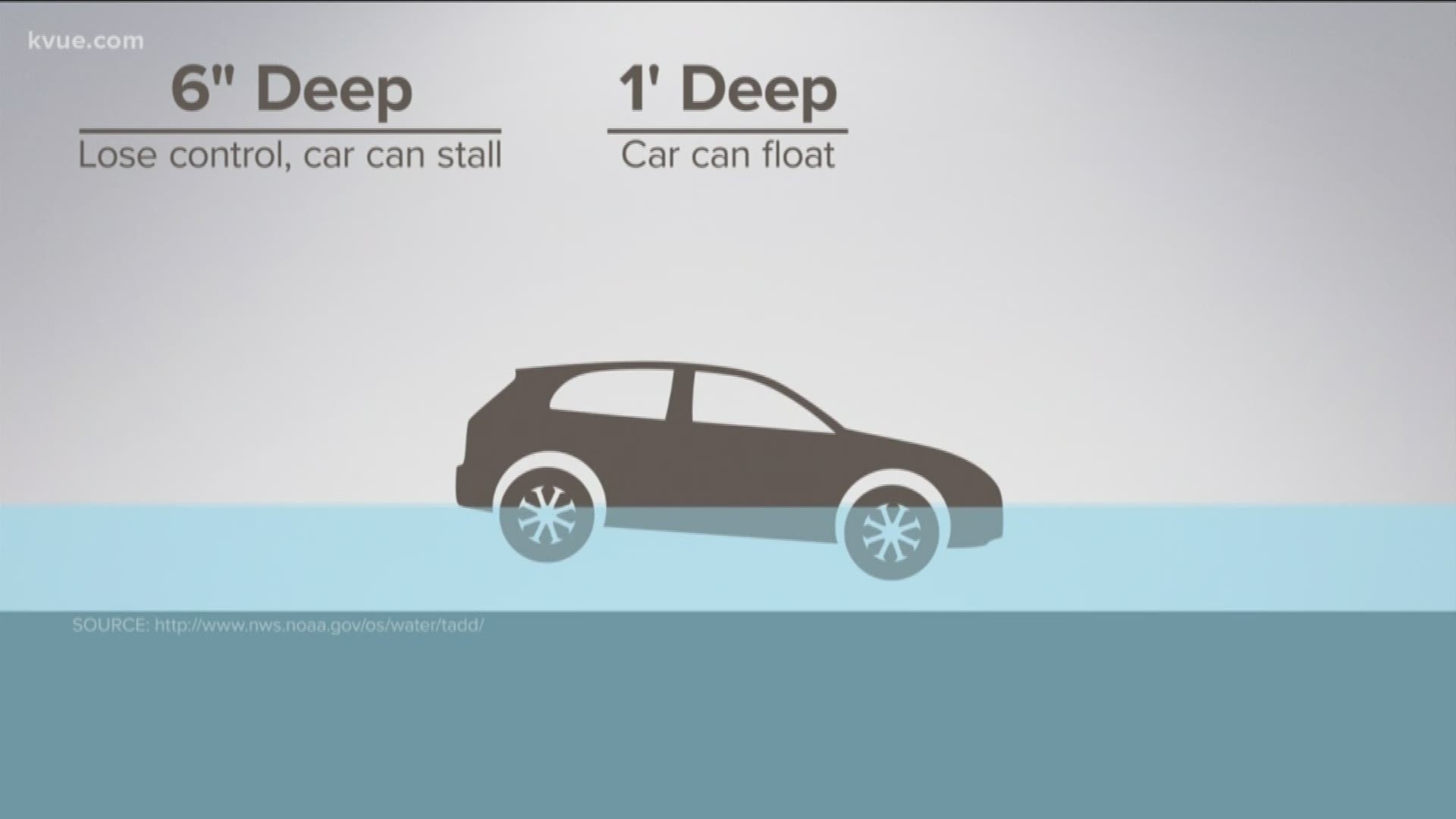AUSTIN, Texas — Editor's note: The video above is a report from May 2019.
Whenever rainy and stormy weather is forecasted in Central Texas, this will include the possibility of severe weather and flooding.
According to the National Weather Service, flooding is consistently ranked as the second-deadliest weather event.
A major risk associated with flooding is cars being swept away by the water. According to the NWS, more than half of all the flooding deaths each year happen in vehicles.
Water as shallow as six inches can stall a car or cause you to lose control. If the water is one foot, smaller vehicles can be swept off the road. If the road is flooded between 18 and 24 inches, larger vehicles can also be swept off the road.
Drive-Texas.org has an updated map of roads with hazards like flooding and debris, which you can check for safety before heading out the door.
Click here to check your local radar.
Driving safety tips during storms
AAA Texas also shared these safety tips all drivers should be aware of during periods of heavy rain.
- Don't try to drive on a road that's covered in water; turn around and find an alternate route.
- If you find yourself in a situation where your car takes on water, leave the vehicle to get to safer, higher ground.
- Don't use cruise control. You get less traction on slick roads.
- Increase your following distance. You'll need more time to react to surrounding traffic.
- Driver more slowly to avoid hydroplaning. AAA Texas says some tires can lose contact with the road even at 35 mph.
- If your vehicle begins to skid, remain calm. Avoid slamming on your brakes; instead, look and steer in the direction you want your vehicle to go.
- Turn on your headlights
Click here to check current traffic conditions.
The NWS has emphasized that during a severe thunderstorm or tornado, people should never stop under a bridge or overpass. The agency said a bridge does not offer protection from strong winds. People can also cause an accident by being stopped under a bridge, the NWS said.
Weather officials also said bridges and overpasses do not protect cars from tornadic winds or debris.
Some safety tips from the NWS include:
- Be Weather-Ready: Check the forecast regularly to see if you're at risk for severe weather. Download the KVUE App for weather updates here: kvue.com/app.
- Sign Up for Notifications: Know how your community sends warning. Some communities have outdoor sirens. Others depend on media and smartphones to alert residents to severe storms.
- Create a Communications Plan: Have a family plan that includes an emergency meeting place and related information. Pick a safe room in your home such as a basement, storm cellar or an interior room on the lowest floor with no windows. Get more ideas for a plan at: https://www.ready.gov/make-a-plan
- Practice Your Plan: Conduct a family severe thunderstorm drill regularly so everyone knows what to do if a damaging wind or large hail is approaching. Make sure all members of your family know to go there when severe thunderstorm warnings are issued. Don't forget pets if time allows.
- Prepare Your Home : Keep trees and branches trimmed near your house. If you have time before severe weather hits, secure loose objects, close windows and doors, and move any valuable objects inside or under a sturdy structure.
- Help Your Neighbor: Encourage your loved ones to prepare for severe thunderstorms. Take CPR training so you can help if someone is hurt during severe weather.
- Stay Weather Ready: Continue to check in with the KVUE Storm Team in our app.
- At Your House: Go to your secure location if you hear a severe thunderstorm warning. Damaging wind or large hail may be approaching. Take your pets with you if time allows.
- At Your Workplace or School: Stay away from windows if you are in a severe thunderstorm warning and damaging wind or large hail is approaching. Do not go to large open rooms such as cafeterias, gymnasiums or auditoriums.
- Outside: Go inside a sturdy building immediately if severe thunderstorms are approaching. Sheds and storage facilities are not safe. Taking shelter under a tree can be deadly. The tree may fall on you. Standing under a tree also put you at a greater risk of getting struck by lightning.
- In a Vehicle: Being in a vehicle during severe thunderstorms is safer than being outside; however, drive to closest secure shelter if there is sufficient time.
Safety tips during a tornado
Some tips to stay safe include:
- Move to an interior room on the lowest level of your home, such as a closet or bathroom.
- If possible, leave mobile homes to shelter with friends or family in a permanent building.
- Never stop under a bridge or overpass.
Remember to download the KVUE app to check the local radar as well as the latest forecast, cameras and current conditions.

